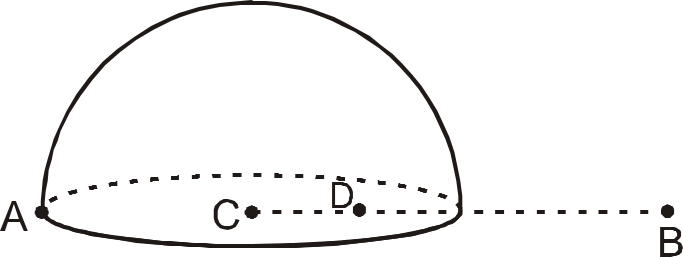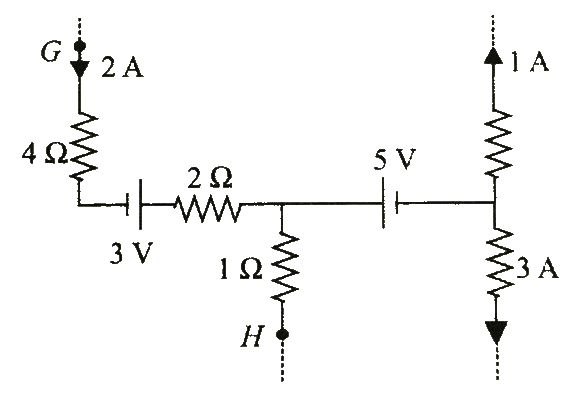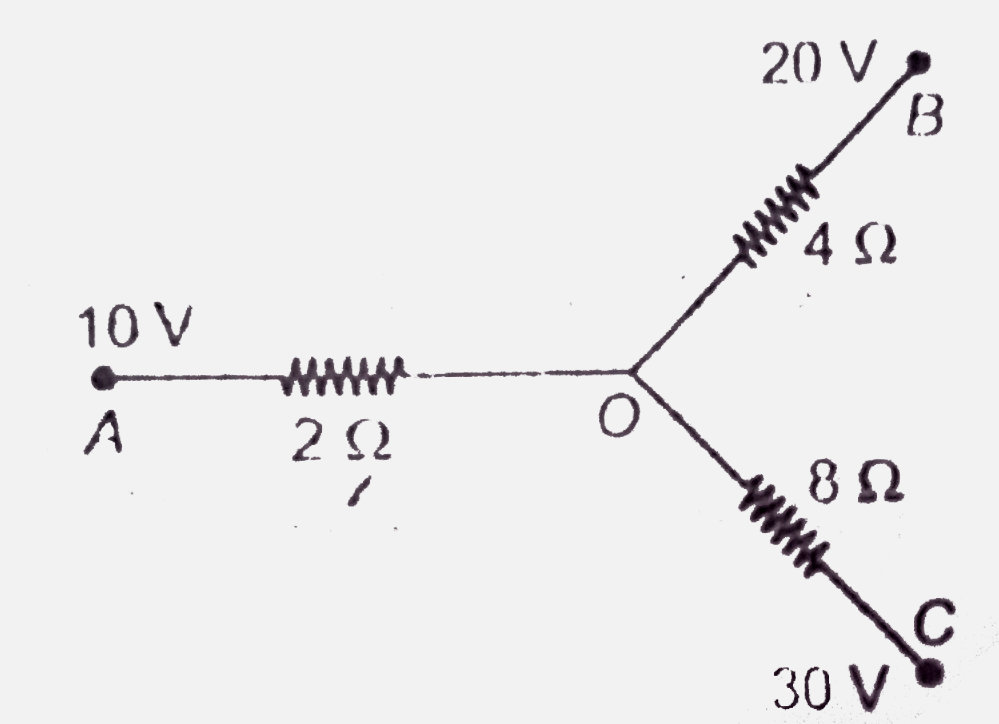Given that a current of 5.0 A passes along the branch from C to B is fig What is the voltage of points A,D,and G? a. VA=………… , b. VD=……………. c. VG=…………..
To solve the problem, we will analyze the circuit step by step to find the voltages at points A, D, and G.
Step 1: Identify the Ground Reference
Since point B is grounded, we can assign it a voltage of 0 volts. Therefore, we have:
VB=0V
Step 2: Determine the Voltage at Point C
Point C is directly connected to point B with no resistance in between. Thus, the voltage at point C is also:
VC=VB=0V
Step 3: Determine the Voltage at Point D
Point D is also connected to point C with no resistance between them. Therefore, the voltage at point D is:
VD=VC=0V
Step 4: Analyze the Circuit to Find Voltage at Point A
Assuming there is a battery connected to point A with a voltage of V volts, we can analyze the current flowing through the circuit. The current flowing from C to B is given as 5 A.
Step 5: Set Up the Current Equations
Let I1 be the current flowing from A to B and I2 be the current flowing from D to G. According to the problem, we know:
I1+I2=5A
Step 6: Express Currents in Terms of Voltage
Using Ohm's Law, we can express the currents in terms of voltage and resistance:
- For I1 flowing from A to B through a resistance R1=7Ω:
I1=VA−VBR1=VA−07=VA7
- For I2 flowing from D to G through a resistance R2=4Ω:
I2=VD−VGR2=0−VG4=−VG4
Step 7: Substitute into the Current Equation
Substituting I1 and I2 into the current equation:
VA7−VG4=5
Step 8: Solve for Voltage at Point A
Assuming VG=0 (as determined earlier), we can simplify the equation:
VA7=5
VA=5×7=35V
Step 9: Determine Voltage at Point G
Since point G is connected to point D with no resistance, we have:
VG=0V
Summary of Voltages
- VA=35V
- VD=0V
- VG=0V
Final Answers
a. VA=35V
b. VD=0V
c. VG=0V
Since point B is grounded, we can assign it a voltage of 0 volts. Therefore, we have:
VB=0V
Point C is directly connected to point B with no resistance in between. Thus, the voltage at point C is also:
VC=VB=0V
Point D is also connected to point C with no resistance between them. Therefore, the voltage at point D is:
VD=VC=0V
Assuming there is a battery connected to point A with a voltage of V volts, we can analyze the current flowing through the circuit. The current flowing from C to B is given as 5 A.
Let I1 be the current flowing from A to B and I2 be the current flowing from D to G. According to the problem, we know:
I1+I2=5A
Using Ohm's Law, we can express the currents in terms of voltage and resistance:
- For I1 flowing from A to B through a resistance R1=7Ω:
I1=VA−VBR1=VA−07=VA7
I2=VD−VGR2=0−VG4=−VG4
Substituting I1 and I2 into the current equation:
VA7−VG4=5
Assuming VG=0 (as determined earlier), we can simplify the equation:
VA7=5
VA=5×7=35V
Since point G is connected to point D with no resistance, we have:
VG=0V
- VA=35V
- VD=0V
- VG=0V
a. VA=35V
b. VD=0V
c. VG=0V
Topper's Solved these Questions
- ELECTRIC CURRENT AND CIRCUITBOOK - CENGAGE PHYSICS ENGLISHCHAPTER - ELECTRIC CURRENT AND CIRCUITEXERCISE - Subjective
29 Videos
- ELECTRIC CURRENT AND CIRCUITBOOK - CENGAGE PHYSICS ENGLISHCHAPTER - ELECTRIC CURRENT AND CIRCUITEXERCISE - Single Correct
72 Videos
- ELECTRIC CURRENT AND CIRCUITBOOK - CENGAGE PHYSICS ENGLISHCHAPTER - ELECTRIC CURRENT AND CIRCUITEXERCISE - Exercise 5.1
28 Videos
- ELECTRIC CURRENT & CIRCUITSBOOK - CENGAGE PHYSICS ENGLISHCHAPTER - ELECTRIC CURRENT & CIRCUITSEXERCISE - Kirchhoff s law and simple circuits
15 Videos
- ELECTRIC FLUX AND GAUSS LAWBOOK - CENGAGE PHYSICS ENGLISHCHAPTER - ELECTRIC FLUX AND GAUSS LAWEXERCISE - MCQ s
38 Videos
Similar Questions
The figure shows a arrangement of capacitors and a battery.

The potential of the points B and D are (if VC=0)
View SolutionThe V−I characteristic of a silicon diode is shown in the Fig. Calculate the resistance of the diode at
(a) ID=15mA and
(b) VD=−10V.
 .
.
View SolutionIn the figure shown there is a hollow hemisphere of radius 'R'. It has a uniform mass distribution having total mass m. The gravitational potential at points A, D and B areVA , VD and VB respectively. Distance of D and B from centre C are R/2 and 2R respectively. The points C, D and B are lying on radial line of the hollow hemisphere

View SolutionIn the part of a circuit shown in fig. 5.266, the potential difference (VG−VH) between points G and H will be

View SolutionIn the circuit element given here, if the potential at point B=VB=0, then the potentials of A and D are given as

View SolutionIn Fig. 5.10, if AC=BD, then prove that AB=CD.

View SolutionIn the uniform electric field shown in figure, find :
a. VA−VD
b. VA−VC
c. VB−VD
d. VC−VD

View SolutionConsider the circuit shown in the figure. Find the current in branch AO and OC . Potential of point A = 10 V of point B = 20 V and of C = 30 V.

View SolutionIn the given branch AB of as circuit a current I=(10t+5)A is flowing, where t is time in second . At t=0, the potential difference between points A and B(VA−VB) is

View SolutionIn the network shown in fig. , points A, B, and C are at potentials of 70 V, 0, and 10V, respectively.

View Solution
